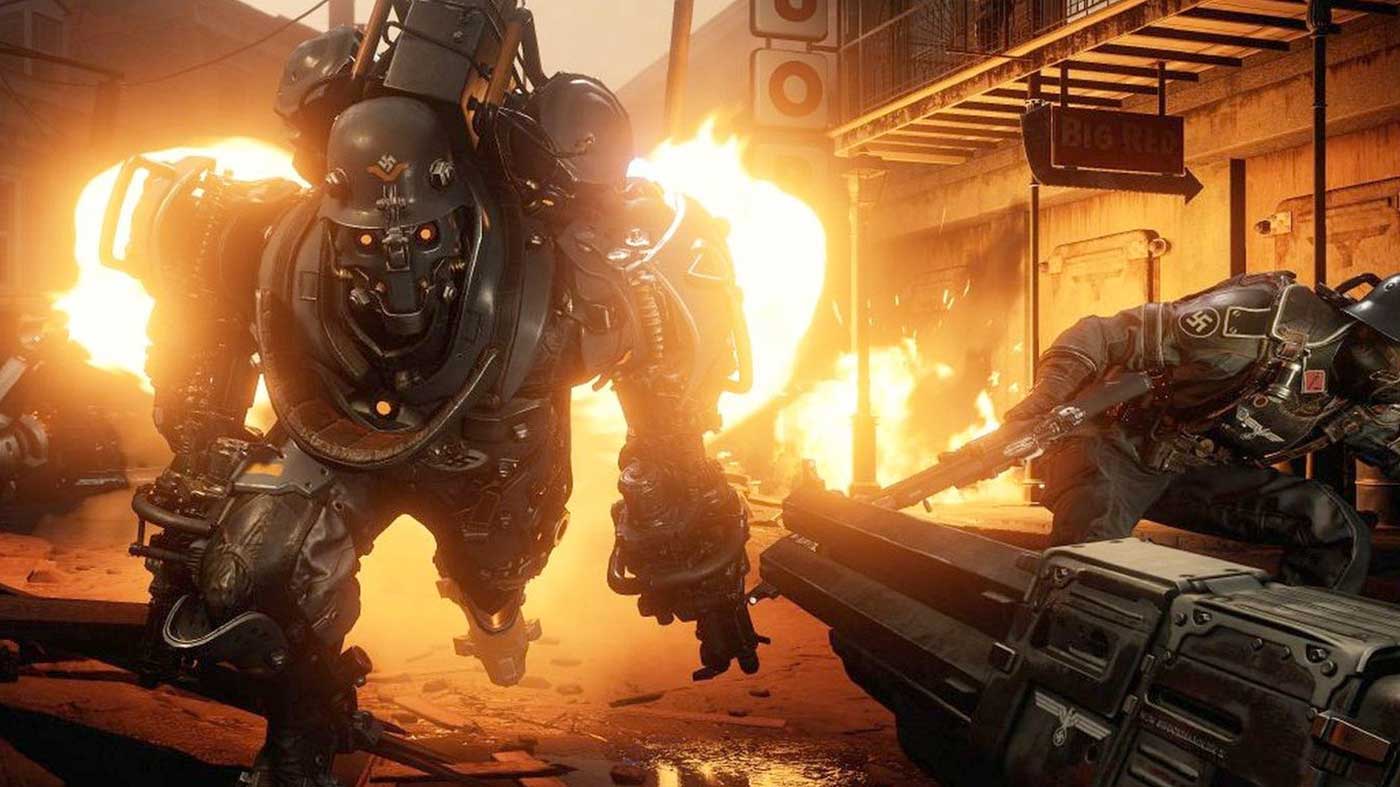Press Start may receive a commission when you buy from links on our site at no extra cost to you.
Wolfenstein finally makes it’s big VR debut, with Doom 2 years ago making a promising start and Skyrim being a fully fledged conversion, will Bethesda continue this string of improved VR releases?
Cyberpilot takes place after Wolfenstein The New Colossus. This time in Nazi occupied France as you aid the French Resistance by turning Nazi robots against their masters as a hacker based in an empty Nazi stronghold. Over four missions you get a taste of three of the most well known robots of the Nazi army, some of which would have been turned into scrap metal by your blazing bullets. This alternative viewpoint is welcome but oddly simplistic, a lack of depth runs through almost every element of Cyberpilot sadly, teasing the potential under the surface but never really opening up fully for you to enjoy.

One area Machinegames has nailed is the narrative framing for the VR experience. Following visual and audible instructions from the resistance you end up with a glimpse of the Paris resistance movement, with moments back at your facility feeling more dynamic than the corridor shooting undertaken as a military drone operator. Before each robot can be sent back out to battle their creators a quick hack must be performed, getting you up close and personal with them to crack open the machine to find their computer chip. While the difficulty of these puzzles are very low the variety certainly helps avoid boredom setting in, even with such a short amount of content to experience.
Each of the three playable robots operate fairly similar and at frustratingly similar speeds. First up is the now iconic Panzerhund, while jumping into its shoes sounds like an awesome moment in reality you are stuck with a fairly basic flame thrower attack with only a dull charge ability to break up the pyrotechnics. Next is the staple of sci-fi, a drone. Although the errand back at base to assemble a prototype weapon may have you thinking you are attaching a delightful instrument of death onto the boring old drone in reality its only attack is a short range taser. With a tiny amount of armour you have only a short period of time from an enemy spotting you until your drone bursts into a thousand bolts and screws so constant use of a cloaking ability is required to navigate to your objectives. Finally the big reveal, the massive walking Zitadelle war machine. This lumbering behemoth of death finally lets you unleash, with a rocket launch for one arm and minigun on the other. Even your special ability is awesome, able to pop a bubble shield while still unleash a barrage of rockets and bullets. All 3 robots have the ability to summon repair drones at any time, with a short windup period.

Unfortunately each robot only has a single solitary mission to undertake before a final mission which has you jumping between them. Each mission is short, with the combat robots being extremely linear to the point where being on rails may have actually increased enjoyment as moving through the streets of Paris is without spectacle or weight. The drone mission is the longest, with multiple objectives that flow in a similar linear fashion but with a logical nature beyond just kill kill kill. Sadly the level design is also bland and restrictive, the versatility of the drone really only comes into play in one large open training room and tactics generally boil down to smart use of your cloaking ability. As every enemy is lethal to the drone you end up in a cycle of trial and error until you learn where each enemy will notice you from, with only the final room giving you good reason to fight back.
The most annoying aspect is how basic your options are for controls in Cyberpilot. Reticle movement is tracked by the right controller with no option for head-tracking which comes across as an astounding omission in a VR game where you pilot machines of death. Face buttons are used for strafing which is awkward since you need to hold the Move button between them at the same time to go forward or backward. Even the menus use the face buttons, not as confirm/cancel but as up and down which makes the experience feel very early VR rather than something releasing nearly three years into the PSVR lifespan. Comfort options are minimal, robot movement is locomotion without any teleport options, turning your robot is again done with the face buttons in increments with (again) no option for head-tracking or motion control. The lack of options really isn’t good enough for the platform in any year, let alone 2019.

The most glaring issue is length, you won’t spend more than 2 hours here, with most being done in 90 minutes. The first 3 missions feel like glorified tutorials for a larger game and the final mission gives a taste of what could be a fantastic, dynamic VR experience but again is so brief it feels like even the end credits took longer to play. After finishing Cyberpilot I couldn’t believe this wasn’t just the introduction of a fully fledged game. With no reason to return to such bog standard combat encounters the amount of work done to create Cyberpilot ends up being sadly wasted.





